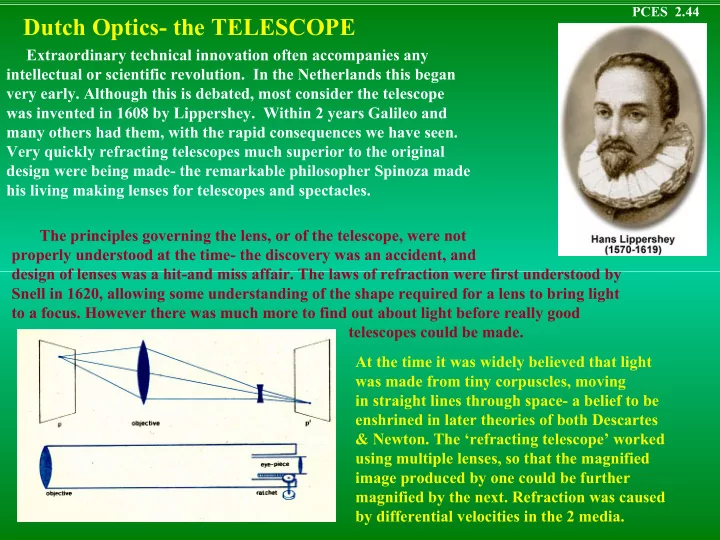

PCES 2.44 Dutch Optics- the TELESCOPE Extraordinary technical innovation often accompanies any intellectual or scientific revolution. In the Netherlands this began very early. Although this is debated, most consider the telescope was invented in 1608 by Lippershey. Within 2 years Galileo and many others had them, with the rapid consequences we have seen. Very quickly refracting telescopes much superior to the original design were being made- the remarkable philosopher Spinoza made his living making lenses for telescopes and spectacles. The principles governing the lens, or of the telescope, were not properly understood at the time- the discovery was an accident, and design of lenses was a hit-and miss affair. The laws of refraction were first understood by Snell in 1620, allowing some understanding of the shape required for a lens to bring light to a focus. However there was much more to find out about light before really good telescopes could be made. At the time it was widely believed that light was made from tiny corpuscles, moving in straight lines through space- a belief to be enshrined in later theories of both Descartes & Newton. The ‘refracting telescope’ worked using multiple lenses, so that the magnified image produced by one could be further magnified by the next. Refraction was caused by differential velocities in the 2 media.
PCES 2.45 The Ideas of C. HUYGHENS (1629-95) Working out of Leiden, Huyghens was an astronomical pioneer, as well as being one of Europe’s foremost mathematicians, and a remarkable physicist. In astronomy he is best known for his explanation of Saturn’s rings- a remarkable piece of deduction (see below)- and his theoretical work on the best form of lenses. However Huyghens’s most important contribution to science by far was his wave theory of light. He argued that the known properties of light, such as the refraction and the propagation in straight lines, could be understood by Huyghens explanation of the appearance of Saturn assuming that light was a wave motion in some invisible medium, analogous to the motion of waves on a fluid. The facts of refraction could be understood by if the Propagation of waves through a lens (Huyghens) waves travelled more slowly in a dense medium (like waves in shallow water). He gave the first mathematical theory of wave propagation, showing amongst other things how they could be built up from ‘elementary wavelets’, radiated in circular patterns from multiple sources.
PCES 2.46 VERMEER and OPTICS Leeuwenhoek It has been widely speculated that Vermeer used some of the new discoveries in optics to help in the execution of his paintings- at least a ‘camera obscura’ being used, and even the uses of lenses to project the image of the subject onto the canvas. ‘The Astronomer’ (Vermeer, 1668) A very interesting speculation, which is unproven, is that Vermeer may have picked up the techniques required to do this from the remarkable Antonie van Leeuwenhoek (1632-1723). Leewenhoek was the executor of Vermeer’s will, and the suggestion is that he made available his understanding of optics to Vermeer, and provided him with lenses. Leeuwenhoek was the pioneer of microscopy- in advance of the rest of the world despite having no university education. It is further argued that Leeuwenhoek was actually the model for the painting above.
PCES 2.47 MICROSCOPES & the discovery of MICRO-ORGANISMS In a series of communications The microscopes of Leeuwenhoek revealed his results Leeuwenhoek could on the discovery of microscopic life magnify up to 180x. (which he called ‘animalcules’), of A nearly spherical lens blood cells, and so on- like a Galileo was held between 2 of the microscopic world, he gave metal sheets, and the detailed reports on everything he microscopic sample saw. placed on a needle It was years before others could whose position could be adjusted with a repeat his results, even in Holland. screw. Below we see results of Robert Hooke (1635-1703), one of the 1 st British scientists to do similar work.
Recommend
More recommend